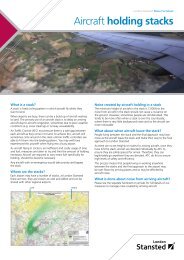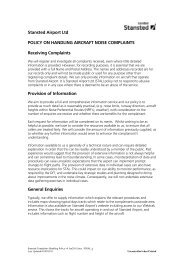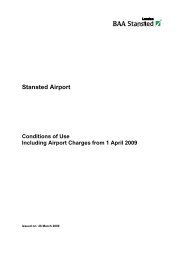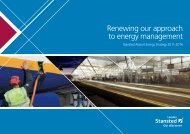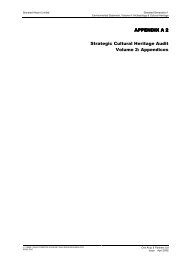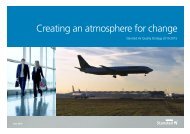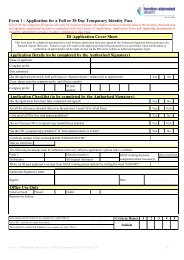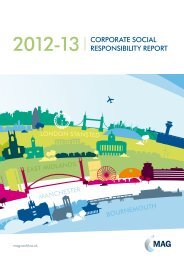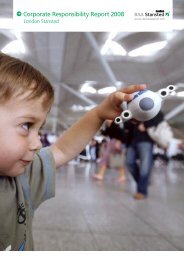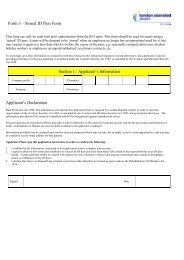Making a material difference - London Stansted Airport
Making a material difference - London Stansted Airport
Making a material difference - London Stansted Airport
You also want an ePaper? Increase the reach of your titles
YUMPU automatically turns print PDFs into web optimized ePapers that Google loves.
3 <strong>London</strong> <strong>Stansted</strong> <strong>Airport</strong><strong>London</strong> <strong>Stansted</strong> <strong>Airport</strong> is the third largest internationalairport in the UK primarily serving <strong>London</strong>, the East of Englandand the South East. In 2009, it handled 20 mppa.It covers an area of 957 hectares and is located approximately65 kilometres north-east of <strong>London</strong>, and 50 kilometressouth-east of Cambridge. Land surrounding the <strong>Airport</strong> ispredominantly arable agricultural land, interspersed withdwellings and farmhouses.Towns in the vicinity of the <strong>Airport</strong> include Bishop’s Stortford,located 3.5 kilometres to the west and Great Dunmowapproximately 8 kilometres to the east. Nearby villages include<strong>Stansted</strong> Mountfitchet, Molehill Green, Bamber’s Green,Takeley, Takeley Street, Birchanger, Burton End, Tye Greenand Gaunt’s End.The <strong>Airport</strong> has one operational runway and a single mainterminal building located to the south of the runway. To thenorth of the runway, a number of general aviation companiesoperate from their own facilities.The main runway is known as ‘04/22’ (based upon compassbearings). It is 3,048m in length and is equipped with aCategory 3b instrument landing system. In 2008, 99 differentaircraft types served the <strong>Airport</strong> with the overwhelming typesbeing twin engine, medium sized, narrow bodied aircraft suchas the Boeing 737-800 and the Airbus A319.<strong>London</strong> <strong>Stansted</strong>’s development<strong>London</strong> <strong>Stansted</strong> <strong>Airport</strong>’s origins date back to the SecondWorld War when the <strong>Airport</strong> was built to provide an airfieldbase for the United States Air Force .The modern airport includes the iconic terminal buildingopened in 1991, having been granted planning permissionin 1985. The permission granted was an initial phase of 8million passengers per annum (mppa), a second permissionof 15 mppa and a third permission of 25 mppa.In October 2008, the Secretary of State approved theGeneration 1 planning application for growth up to 35 mppaalong with a series of conditions and obligations. Theseconditions restrict passenger numbers up to 35 mppa, airtransport movements to 264,000 and the area within the57dB LAeq noise contour to 33.9 square kilometres.<strong>Airport</strong> useOn average the <strong>Airport</strong> handles approximately 500 flightsper day in the winter period and 600 flights per day in thesummer period - these being evenly split between departuresand arrivals.In summer 2009, there were 19 scheduled and charterpassenger airlines flying to over 140 destinations. The total AirTraffic Movements (ATM’s) for 2009 were 156,233.The <strong>Airport</strong> serves a catchment area of over 12 million peoplein the East of England, <strong>London</strong> and the wider South East.Over 3 million business passengers use <strong>London</strong> <strong>Stansted</strong><strong>Airport</strong> each year. In 2009, 199 companies and agencies werelocated on-airport; employing about 11,000 people, 80% ofwhom live in Essex and Hertfordshire.<strong>London</strong> <strong>Stansted</strong> <strong>Airport</strong> | Waste Management Strategy 2010–2015 | November 2010 7
8“There are three levelsof regulation whichgovern waste at<strong>London</strong> <strong>Stansted</strong> <strong>Airport</strong>,these are at European,national and local level”
Waste Strategy for England 2007The Government’s Waste Strategy for England 2007 sets outto protect human health and the environment by producingless waste and by using it as a resource wherever possible.The Waste Strategy replaces the Government’s Waste Strategy2000 and sets the following objectives:• Decouple waste growth (in all sectors) from economic growthand put more emphasis on waste prevention and reuse• Meet and exceed the Landfill Directive diversion targets forbiodegradable municipal waste in 2010, 2013 and 2020• Increase diversion from landfill of non-municipal wasteand secure better integration of treatment for municipaland non-municipal waste• Secure the investment in infrastructure needed to divert wastefrom landfill and for the management of hazardous waste• Achieve most environmental benefit from that investment,through increased recycling of resources and recovery ofenergy from residual waste using a mix of technologies.The Waste Strategy sets more ambitious targets than thoseincluded in the Waste Strategy 2000. These are to increaserecycling and composting of household waste to 40% by2010, 45% by 2015 and 50% by 2020.Planning Policy Statement (PPS10) - Planning andWaste Management (July 2005)PPS10, Planning for Sustainable Waste Management reflectsthe expectations of the Government’s Planning Green Paper,Planning - delivering a fundamental change. Planning PolicyGuidance 10 (PPG10) provides clarity on what is requiredat regional and local levels. It aims to ensure that decisionsare made at the most appropriate level and in a timelymanner that delivers sufficient opportunities for sustainablewaste management.The guidance states that positive planning has an importantrole in delivering sustainable waste management:• Through the development of appropriate strategies forgrowth, regeneration and the prudent use of resources• By providing sufficient opportunities for new wastemanagement facilities of the right type, in the rightplace and at the right time• The key planning objectives require regional planning bodiesand planning authorities to prepare and deliver planningstrategies that include:– Helping to deliver sustainable development through drivingwaste management up the waste hierarchy, addressingwaste as a resource and looking to disposal as the lastoption but one which must be adequately catered for– Enabling sufficient and timely provision of wastemanagement facilities to meet the needs of theircommunities– Helping to implement the national waste strategy, andsupporting targets, and are consistent with obligationsrequired under European legislation– Helping to secure the recovery or disposal of wastewithout endangering human health and without harmingthe environment, and ensuring waste is disposed of asnear as possible to its place of production– Reflecting the concerns and interests of local communities,the needs of waste collection authorities, waste disposalauthorities and business, and encouraging competitiveness– Ensuring the layout and design of new developmentsupports sustainable waste management.British Standard 5906:2005 Waste Managementin Buildings - Code of PracticeThis Standard provides recommendations for methods ofstorage and on-site treatment of solid waste from residentialand commercial buildings and hospitals, with the exceptionof medical waste.It recognises that at an early stage in design, it is essentialthat agreement is reached between the designers andappropriate authorities.In particular, attention is paid to the methods of storage,segregation, on-site treatment and collection of waste,including recyclable <strong>material</strong>, to be used for the form oflayout and building density adopted.<strong>London</strong> <strong>Stansted</strong> <strong>Airport</strong> | Waste Management Strategy 2010–2015 | November 2010 11
1414“50% of the wastecollected, is generatedby retailers andpassengers inthe Terminal.”
905 Waste at <strong>London</strong> <strong>Stansted</strong> <strong>Airport</strong> continuedA more detailed breakdown of the specific types of wasteproduced is described in the following sections:Hazardous wasteHazardous wastes collected under the main contract include oilcans generated through aircraft stand maintenance, dangerousitems surrendered at security and redundant electrical equipment.Hazardous waste streams including lamps, oils, chemicalsand batteries which are generated by STAL’s engineering andmaintenance departments are generally removed by hazardouswaste specialists. In 2006, we started to record information onthese waste sources, to allow us to monitor compliance andrecycling more effectively.Hazardous waste generated by <strong>Airport</strong> companies is notpermitted in the <strong>Airport</strong>’s waste collection facilities. Werequire that <strong>Airport</strong> companies make their own arrangementsfor disposal of these wastes. This includes aircraft cateringwaste which may contain category 1 animal by-products.CompostingLandscaping waste (e.g. grass cuttings from verges andthe airfield, tree/hedge trimmings etc) is composted atthe <strong>Airport</strong>’s composting site. The compost is used by ourlandscape maintenance contractor within the boundaryof the <strong>Airport</strong> to maintain the landscape environment. Onaverage approximately 600-800 tonnes of green waste per yearis composted and reused in this way. We track this wasteand include composting as part of our recycling target.Waste generated by business partners.Where our business partners (retailers, tenants, airlines andcontractors) subscribe to our waste collection service, we areable to track waste quantities and types through the dataprovided by our main waste contractor.Some <strong>Airport</strong> companies choose to make their ownarrangements for waste disposal including cargo facilities,hotels and some aircraft hangers. We currently do not trackthese waste streams and as such the data is not included inthe analysis provided in this strategy.Construction wasteConstruction waste at the <strong>Airport</strong> is largely generated fromconstruction of infrastructure and facilities as well as buildingmaintenance activities. As far as practicable, all pavementand concrete waste is reused on-site for construction purposes.Materials which cannot be reused on site will be recycled,or disposed of via a licensed waste management contractoras part of each project. Currently about 85% of thewaste <strong>material</strong> from STAL’s construction operations isrecycled. Construction waste is monitored separately fromoperational waste streams and again is not included in theanalysis opposite.In 2009, 5,385 tonnes of waste was generated on-airport.Figure This 5: includes Comparison 4,689 of tonnes Total Waste collected and by Waster our waste Per Passenger contractor, at <strong>Stansted</strong> <strong>Airport</strong>683 tonnes of green waste composted on-site and smallquantities of hazardous waste removed by specialists.7000We also measure waste produced per passenger to allow us6000 to better compare year on year waste as the <strong>Airport</strong> grows.5000 Figure 6 compares annual performance of the total volumesof waste collected by our contractor and the waste per4000passenger. This shows that total waste collected grew from3000 2001 until 2006 and has decreased each year since then.2000 Waste per passenger also peaked in 2006, then decreasedand has remained relatively stable over the last two years.1000One of the most significant contributors to the increasedlevel 0 of waste produced in 2006 was the introduction of2002/03 2003/04the security restrictions for passengers travelling with liquidsand gels during heightened security levels. This increasedwaste generated in the Terminal by almost 20%.Tonnage2001/02 2004/05 2005/06 2006/0Figure Figure 5: Comparison 6: Comparison of of Total total Waste waste and and Waster waste Per per Passenger passenger at <strong>Stansted</strong> <strong>Airport</strong>at <strong>London</strong> <strong>Stansted</strong> <strong>Airport</strong>Total waste Waste per paxTonnageWaste quantitiesThe data provided by our main waste contractor allowsus to accurately track how much waste is collected underthis contract.7000 0.30600050004000300020000.250.200.150.101000 0.05kg/pax160 0.002001/02 2002/03 2003/04 2004/05 2005/06 2006/07 2007 2008 2009YearSource: <strong>Stansted</strong> Generation 2 Environment Statement - Volume 15Figure 8: Waste disposal methodsComposting Recycling Incineration Hazardous waste disposal R100
5 Waste at <strong>London</strong> <strong>Stansted</strong> <strong>Airport</strong> continuedFigure 8: Waste production and disposalStaffPassengersRetailoutletsOfficesHandlingagentsAirlinesEngineeringWaste producersTenantedbuildingsEstatemanagementConstructionAircraftcleanersCentralsearchAircraftmaintenanceVehiclemaintenancePackaging Paper CansBuilding<strong>material</strong>sDrinks Food ClinicalTyresWaste oilsCardGlassPlasticsSanitaryInternationalcatering wasteAerosols Oil filters Batteries Clothing Soil Green waste Wood palletsWaste generatedWaste recycling and disposalIn consultation with STAL, the <strong>Airport</strong>’s waste contractor makesarrangements for the removal of waste to local waste disposal,treatment or reprocessing sites.ConfiscatedgoodsRedundantcomponentsWEEEThrough our contract management process we regularly reviewthe availability of local waste sites to ensure that we maintainan efficient operation. This enables us to prioritise recyclingover other disposal means and take account of the proximityprinciple as far as possible.Variousreprocessingfacilities forcardboard,paper, glass,metal & woodOn sitecompostingMRFRecyclingMBTEvaporationSourcesegregationRecoveryfor energyOn sitereuseHazardouswaste siteRecyclingOn <strong>Airport</strong> wastemanagementOff <strong>Airport</strong> wastemanagementWe are therefore able to identify how waste generated acrossthe <strong>Airport</strong> by a range of waste producers is disposed of (Figure8). We make use of a number of different waste treatment anddisposal facilities including:• Recycling sites for paper, cardboard, metal, glass etc,• Sorting and treatment of general terminal waste at amechanical, biological treatment plant (MBT)• Sorting and recycling of mixed recyclables such as plastics,paper, card at a <strong>material</strong> recycling facility (MRF)Landfill• Sorting, treatment and recycling of hazardous waste at aspecialist treatment facility• Our on-airport composting site.Some waste is still sent to landfill, although this has decreasedas we have increasingly prioritised other disposal routes.18
Tonnage4000300020001000 0.050 0.002001/02 2002/03 2003/04 2004/05 2005/06 2006/07 2007 2008 2009 to date0.200.150.10kg/paxFigure 5: Comparison of Total Waste and Waster Per Passenger at <strong>Stansted</strong> <strong>Airport</strong>Waste recycling and recoveryFigure 10: Breakdown of recycling by <strong>material</strong>Total waste Waste per paxSince 2004, we have increased the proportion of waste werecover, 7000 recycle and compost and have significantly reduced 0.30Re-fit waste (3%)Sweepings (9%)Cardboard (18%)our 6000 reliance on landfill (Figure 9). Figure 10 shows how our0.25recycled <strong>material</strong>s breakdown by <strong>material</strong>.Hazardous waste (5%)50000.20Recycling is our priority for the waste we generate. Recovery ofRecycling at4000MRF (4%)residual waste for use in energy generation is a beneficial use 0.153000of the waste we can’t recycle. Nine percent of our waste was0.10recovered 2000 for energy in 2009 at an MBT facility.Recycling at1000 0.05 Composting (32%)MBT (18%)Tonnage0 0.002001/02 2002/03 2003/04 2004/05 2005/06 2006/07 2007 2008 2009YearFigure 8: 9: Waste disposal methods and recycling methodsPercentageFigure 10: Waste recycling ratesentage10090807060504030201005045403530Contract recyclingTotal <strong>Airport</strong> recyclingkg/paxGlass (4%)Pallets (4%) Metal (3%)Wood (0%)Composting Recycling Incineration Hazardous waste disposal Recovery at MBT Moisture loss at MBT Landfill2003/04 2004/05 2005/06 2006/07 2007 2008 2009Figure X: Recycling targetspercentage10090807060Forecasting future <strong>Airport</strong> waste productionIn developing our Strategy, we have considered the wastecurrently produced at the <strong>Airport</strong> as well as the waste weexpect the <strong>Airport</strong> to produce in the future. As part of the G1planning application, a forecast of waste based on the <strong>Airport</strong>operating at 35 million passengers per annum (mppa) wasmade. This was done in two ways, first by predicting the wasteproduced by the proposed facilities and secondly by predictingthe waste generation by passenger throughput (Table 2).This waste production forecast has helped shape this strategy.In the future we will regularly review our development plans toensure that our waste forecasts and collection services remainfit for purpose and meet demand.Table 2: Forecast waste for the 35 mppa in 2014Waste source description totalTonnesBaseline waste figure 2004/06 6,038Additional facilities25 mppa permitted development. 1,449Additional Hotels: South Gate Hotel West (250 beds) 192and South Gate Hotel East (100 beds).Additional Restaurant: South Gate Restaurant. 246Additional Car Rental Sites 5 and 6. 7SUB-TOTAL 1,888Additional passenger throughput to 35 mppaThere are an additional 10 mppa passing through 2,500the <strong>Airport</strong>. It is assumed that each passenger willgenerate 0.25 kg of waste associated with theTerminal, satellites, aircraft and aircraft stands.TOTAL 10,426Source: STAL Generation 1 Environment Statement Volume 13 Waste, Page 13Herts CC Essex C C STAL<strong>London</strong> <strong>Stansted</strong> <strong>Airport</strong> | Waste Management Strategy 2010–2015 | November 201019
“Our target isto recycle 60% ofwaste and send nowaste directly tolandfill by 2015”20 20
6 <strong>London</strong> <strong>Stansted</strong> <strong>Airport</strong>’s Waste Management StrategyOur visionOur vision is that waste and resource efficiency will be anintegral part of our business decision making, demonstratingleadership and continual improvement in environmentalgood practice.To achieve our vision we have developed five guiding principles:• Clear policies on resource efficiency and wastemanagement, building on the principles laid out in theUK Government’s Waste Strategy to produce less waste,purchase responsibly and separate waste for recycling• An <strong>Airport</strong> community which is incentivised to prevent,reuse and recycle waste• Implementation of the ‘polluter pays’ principal throughappropriate charging mechanisms• Purchasing and design decisions which take resourceuse and waste into account• The right infrastructure to enable delivery of recyclingand landfill diversion targets.Our targetsOur targets are to:• Achieve zero waste sent directly to landfill from the<strong>Airport</strong>, with at least 60% of waste recycled by 2015and 70% recycling by 2020• Maintain 100% compliance with legal requirements• Ensure as the <strong>Airport</strong> grows, it does so with no increasein waste produced per passenger in 2006 by 2015.Our approachAt <strong>Stansted</strong>, we aim to exceed the minimum compliancerequirements and are fully committed to reducing the impactof waste produced at the <strong>Airport</strong>. To achieve this we havedeveloped a robust approach to waste contract managementand have put in place the appropriate infrastructure to enablegood practice in segregating waste streams for recycling.Additionally, we actively encourage <strong>Airport</strong> staff and thirdparties to participate in our recycling programmes.It is important to ensure that our approach remainsappropriate, so we regularly review how and where wasteis produced to ensure that the most appropriate collectionand disposal/recycling services are provided. Our recyclingperformance to date has been achieved through thesegregation of waste at source for the main recyclable<strong>material</strong>s and further off-site sorting of the remaining wastes.In adopting this approach we have significantly reduced ourreliance on using landfill as a means of waste disposal.However, we recognise that there are further opportunitiesfor improvement, which will enable us to move up thewaste hierarchy.In developing our Waste Strategy we have focussed on sixheadline themes and developed an Action Plan for each theme.The themes are:1. Waste prevention2. Reuse3. Recovery - recycle, composting, energy4. Disposal5. Working with our stakeholders6. Continual improvement and innovationOperationalwasteactivitiesManagementand controlactivitiesThis Strategy will evolve during its implementation period.Where appropriate, it will be revised and updated toreflect developments in government policy and regulation,scientific knowledge, stakeholder feedback, company policy,infrastructure changes and changes in airport operations.The Action Plan has timescales for delivery and whereappropriate key performance indicators have been developedto measure performance. We will regularly review ourperformance against these indicators and publish our progressin the annual Corporate Responsibility Report.<strong>London</strong> <strong>Stansted</strong> <strong>Airport</strong> | Waste Management Strategy 2010–2015 | November 2010 21
6 <strong>London</strong> <strong>Stansted</strong> <strong>Airport</strong>’s Waste Management Strategy continuedOur Strategies6.1 Waste PreventionThe quantities and types of waste produced at <strong>London</strong><strong>Stansted</strong> <strong>Airport</strong> depend largely on the activities of ourbusiness partners, contractors and passengers. In 2009, 20million passengers travelled through <strong>Stansted</strong> and there were10,859 people employed by 199 companies. In many cases,STAL can only influence these individuals and companies toreduce the waste brought to, and produced, at the <strong>Airport</strong>.However, we recognise that we can do more by furtherintegrating resource efficiency into our decision makingprocesses. For example finding ways to prevent waste throughprocurement and construction design decisions. We can alsolead by example by encouraging and supporting our own staffto find less wasteful ways of working.The majority of waste is generated in the Terminal, of whicha high proportion is packaging (Figure 5). We are committedto working with our retailers and concessionaires to reducepackaging waste and where this is not possible, to encouragereuse or recycling.STAL can also support the UK’s broader waste preventionand recycling goals by buying recycled products or <strong>material</strong>s.We understand that customer concerns (either perceivedor real) about the cost and quality of recycled productscan limit options for buying recycled. We will take accountof developments in this area such as the Waste andResources Action Programme’s (WRAP) quality protocolsfor waste products 1 .Baggage restrictions: In 2006, when new restrictions ongels and liquids were introduced by the UK Government, thequantity of waste generated in the terminal increased by 17%,almost overnight. In response, STAL initiated an advertisingcampaign to ensure that passengers knew what they couldtake on board the aircraft in hand luggage. This reduced thequantities of restricted items we had to dispose of. We alsoprovide information on other unauthorized items such asChristmas crackers, wrapped presents and sharp objects.Reducing construction waste: Our Soil ManagementStrategy requires that any excess soil generated by diggingout or levelling works is stored in a suitable location for usein future works.Action plan summary• Develop a framework for incorporating resource efficiencyand waste minimisation considerations into procurementand supply chain decisions by end of 2013• Review and update our guidelines for <strong>Airport</strong> developmentand building design by end of 2012• Review packaging waste generated by retailers andpassengers in order to identify waste reductionopportunities by end of 2011• Review resource use and waste generated by STALoperations to identify and implement opportunities for wastereduction and for using recycled products by end of 2011.1WRAP’s quality protocols provide guidance as to when waste <strong>material</strong> is consideredto be fully recovered and is no longer classed as a waste. They also provide users withinformation on the quality of <strong>material</strong> they are purchasing if the protocol is followed.http://www.wrap.org.uk/recycling_industry/quality_protocols/index.html22
6.2 Waste reuseTo date our main focus for reuse has been on reusing construction<strong>material</strong> in our development projects. This not only reduceswaste but also reduces the cost of buying raw <strong>material</strong>s.In some areas, the potential for reuse can be limited dueto concerns over quality, safety or meeting expectations ofcustomers. However, we recognise that there are furtheropportunities at the <strong>Airport</strong> for reducing waste products ortheir component parts. We could reuse more waste on-site,such as using ash from our biomass boiler as compost. Wecan also make more use of off-site opportunities throughcharitable donations or by linking up with reuse networks,such as furniture reuse programmes or the National IndustrialSymbiosis Programme (NISP).Construction: We have prioritised reuse of <strong>material</strong> as far aspossible in our construction processes. Projects have included:• Use of crushed concrete from taxiway repairs in thefoundations of Hangar 3 which was rebuilt in 2009• Use of planing’s from runway resurfacing works in 2006 forimproving the road surfaces on landside roads and creatingnew cycle and footpaths.Packaging: We actively encourage our business partnersto reuse delivery packaging such as metal cages and pallets.Where these items have been abandoned we will endeavourto return to the owner or, where appropriate, collect for reuseby another interested party. Any pallets in good condition aretaken for reuse by a food delivery company.Staff uniforms: In 2009, old staff uniforms were given tosupporters of Help the Heroes Charity who used them tocreate quilts for injured British servicemen and women.Action plan summary• Continue to reuse construction waste as far as possible andamend construction standards to reflect best practice in<strong>material</strong> reuse• Review reuse opportunities across the <strong>Airport</strong> and howwe can collaborate with external parties by end of 2011• Revise our building refurbishment guidance to includeonsite and offsite reuse opportunities for furniture, electricalequipment and other items by end of 2011• Where feasible reuse tree, vegetation pruning and coppicingwaste as a woodchip source for our biomass boiler (subjectto technical review) and reuse the ash from our biomassboiler as a soil improver along with our composted grass byend of 2011.6.3 Recovery - recycle, composting, energySTAL’s approach to recycling is to segregate key waste streamsat source such as cardboard, paper, glass and metal andto send remaining mixed waste for further sorting off-site.In line with the waste hierarchy, we prioritise recycling andcomposting over using our waste to create energy, referred toas energy recovery.The success of our recovery and recycling programmes dependson a number of factors including:• The availability of local and regional sorting, reprocessingand treatment facilities• The collection facilities and services we provide to theairport community• The behaviours of users of our facilities - we rely onusers to use waste facilities correctly and make use ofrecycling collections• Effective partnerships with our waste and cleaningcontractors and our business partners.In 2009, 43% of airport waste was recycled or composted.This included recycling of 35% of the waste collected bythe <strong>Airport</strong>’s waste contractor and on-site composting of anadditional 683 tonnes of landscaping waste. A further 9% ofcontract waste was recovered for use as fuel. This representsa significant increase in recycling over the last five years(Figure 11). An important contribution to this increase wasmade through the use of off-site sorting facilities for wastewhich is difficult or impractical to separate at source. Wecurrently use the following off-site sorting facilities:• A local <strong>material</strong>s recycling facility (MRF) for mixed ‘dry’recyclables such as plastics bottles, plastic wrap, cans,card and paper which are not contaminated with organic‘wet’ wastes such as food• A mechanical biological treatment (MBT) facility for ourresidual waste from the terminal, for further treatment andsorting into recycling and <strong>material</strong> suitable for energy recovery• A hazardous waste treatment site where the waste is sortedand recycled where possible. This includes oil cans fromaircraft stand maintenance, meaning both the oil and metalcans can be recycled.<strong>London</strong> <strong>Stansted</strong> <strong>Airport</strong> | Waste Management Strategy 2010–2015 | November 2010 23
Percenta605040306 <strong>London</strong> <strong>Stansted</strong> <strong>Airport</strong>’s 20 Waste Management Strategy continued1002003/04 2004/05 2005/06 2006/07 2007 2008 2009Passenger and staff recycling: In 2009, we installed recyclingbins throughout the terminal and satellites for collection ofpaper (newspapers and magazines) and plastic bottles. Wehave also installed the bins in the bus station and commonstaff areas.Composting: We started composting our waste as a trialin 2004-05. The success of our trial lead to role out of apermanent composting operation. In 2009, we compostedalmost 700 tonnes of green waste. This not only significantlyreduces waste to landfill and the associated costs, but alsoreduces the cost of fertilizing our managed landscape areas.In order to meet our goal of 60% recycling by 2015, werecognise that we have to drive forward further improvementsto maximise our existing recycling routes and identify newrecycling opportunities, such as for food waste from ourcatering outlets. We will continue to review our waste streamsto ensure we are providing the right collection infrastructureand services on the <strong>Airport</strong>.Figure 10: 11: Waste recycling ratesPercentage5045403530252015102004/05Contract recyclingTotal <strong>Airport</strong> recycling2005/06 2006/07 2007 2008 2009Action plan summary• Implement a collection service for food waste generatedby catering outlets in the terminal by 2010• Encourage increased use of existing recyclingcollection services through communication, trainingand appropriate incentives• Annually set recycling targets for our cleaning andwaste contractors• Regularly review local recycling waste treatmentinfrastructure and our collection services to ensure newrecycling and recovery opportunities are identified• Undertake an assessment of our component waste streamsto identify further opportunities for increasing recycling byend of 2013.Figure X: Recycling targets6.4 Waste disposalHerts CC Essex C C STALWaste disposal at 100 landfill sites is considered the last resortafter prevention, reuse and recovery have been considered.90Avoiding landfill reduces our contribution to the negativeimpacts of waste 80 disposal, including the contribution oflandfills to climate 70change. Furthermore, strict environmentalcontrols and decreasing availability of space means that we are60increasingly restricted on the types and quantities of waste wecan send to landfill. 50The escalating landfill 40 tax which is due to increase to £72 pertonne by 2013 and 30 the practical implications of having to lookfurther afield for available disposal space, mean that this is a20key focus for STAL.10Our approach is to eliminate waste sent directly to landfill0from the <strong>Airport</strong> by 2015. 2010 We have focused 2012this Strategy 2015 and 2020our Action Plan primarily on the activities that will promotethis move up the waste hierarchy.One of our main challenges in achieving zero waste tolandfill is the risk presented by aircraft catering waste whichare classed as category 1 animal by-products 2 . Although weprohibit this waste from our facilities, the risk of contaminationcurrently limits our options for recycling aircraft wastes. Wehave been working with other airports through the UK <strong>Airport</strong>sand Airlines Recycling Group, as part of the UK SustainableAviation Initiative, (www.sustainableaviation.co.uk), to sharegood practice and potential solutions to this problem.Target percentageAction plan summary• Investigate and implement alternative arrangements forall waste streams still sent directly to landfill from the<strong>Airport</strong> by 2014• Continue to work with other airports and Government todevelop appropriate processes for aircraft waste in orderto facilitate recovery/recycling of aircraft waste streams.242Aircraft catering waste containing meat originating outside the EU are considered to presenta risk to human or animal health and stringent controls on waste disposal are required.
6.5 Working with our stakeholdersThe engagement of our stakeholders is crucial to the successof this Strategy. Our stakeholders are:• Staff and companies operating at the <strong>Airport</strong> whocontribute to the <strong>Airport</strong>’s waste and/or use the <strong>Airport</strong>’swaste collection facilities• External organisations with an interest in our wastemanagement performance, such as local authoritiesand regulators• Those with whom we could collaborate to achieve commonobjectives, and waste technology companies who couldhelp implement innovative solutions at the <strong>Airport</strong>.On-airport stakeholdersOn-airport, it is the behaviours and involvement of employees,<strong>Airport</strong> companies and contractors which determines how wellwe perform against our recycling targets.We recognise that there are significant challenges in engagingthe <strong>Airport</strong> community due to the unique nature of airportoperations. There are a number of factors that makeparticipation in recycling schemes more difficult including:• Fast turnaround of aircraft typical of the low cost sector• Busy retail and food outlets in the Terminal• Communication with a large workforce.It is essential that we find effective ways to engage withemployees and business partners to ensure the services weprovide meet their needs and facilitate their involvementin meeting the <strong>Airport</strong>’s objectives. We believe thatencouraging good practice requires the right mix of effectivecommunication, training, partnership working and incentives.Communication and trainingGiven the wide range of activities, job roles and companiesoperating at the <strong>Airport</strong>, our communication plans mustutilise a number of different techniques. These include use ofelectronic media (information screens, email, intranet), posterand leaflet campaigns, face-to-face communication throughteam meetings, numerous business partner forums such as the<strong>Airport</strong> Operators Committee (AOC), our contractors forumand more formal training.We recognise that a more structured, concerted approach onwaste management with specific communication and trainingis required, if we are to achieve the further step change inrecycling to meet our targets.Staff training: In 2009, we developed and delivereda series of environmental tool box talks which includedwaste management as a key theme. Over 40 staff from ourengineering, fire service and operations departments attended.To embed the training we have provided clear instructions asto how the different waste streams they produce should bedisposed of. This has led to increased engagement in recyclingand a reduction in occurrence of problems caused by incorrectdisposal. We have now incorporated this training requirementinto our engineering training plans.Our contractorSTAL views its main waste contractor as a critical partner inachieving its recycling and landfill diversion targets in a costeffective way. We have incentivised recycling through thecontract pricing mechanism and we track performance throughkey performance indicators. We have also recognised theneed to incentivise other contractors who have a role in wastecollection such as <strong>Airport</strong> cleaning companies.<strong>London</strong> <strong>Stansted</strong> <strong>Airport</strong> | Waste Management Strategy 2010–2015 | November 201025
6 <strong>London</strong> <strong>Stansted</strong> <strong>Airport</strong>’s Waste Management Strategy continuedIncentivising usersWhere appropriate STAL will use financial incentives to encouragethe right behaviours. We cross-charge users of our wasteservices based on the ‘polluter pays principle’, with recyclingcollected for a significantly lower charge than general waste.Financial incentives: In 2008, we reviewed how we charge<strong>Airport</strong> companies for the waste service we provide. Weintroduced a “pay as you throw” bag collection charge inthe Terminal with free collections of cardboard and glass forrecycling. We also simplified our charges for tenants acrossthe <strong>Airport</strong>. To back this up we have provided clear instructionson waste disposal to our business partners and will provide1-2-1 support if required.We have also built into our charging mechanisms financialpenalties for poor performance. Where problems arise, ourpreferred approach is always to work with a retailer or tenantto help them improve their performance. However, where theiractions, such as fly-tipping or incorrect disposal of hazardouswaste, could lead to increased cost or compliance risks to ourbusiness, we impose fair but firm penalties.We recognise that incentives do not have to be financial.Publishing case studies of good practice can inspire others toimprove their performance too.Action plan summary• Incorporate waste management into the <strong>Airport</strong> trainingand communication plans and review annually• Deliver at least two <strong>Airport</strong>-wide waste awarenesscampaigns or events by 2015• Develop a good practice award scheme in wastemanagement as part of a broader environmental goodpractice programme by the end of 2011• Incorporate incentives into cleaning and waste contractsto encourage recycling by the end of 2010• Review annually our waste charges and continue to offerfree/low cost recycling collections• Identify our main waste producers on-airport and developplans to work in partnership with them.Collaborating with external stakeholdersCollaborating with external organisations such as localauthorities, industry groups, regulators, and local or nationalsupport networks can help drive forward our plans. Theseorganisations can provide access to information aboutdevelopments in the waste management sector, innovationand best practice opportunities.We are an active signatory to the UK Sustainable AviationInitiative. Sustainable Aviation is a comprehensive strategy forthe long-term sustainability of the UK aviation industry. Thispioneering initiative brings together the UK’s leading airlines,airports, aerospace manufacturers and air navigation serviceproviders. In the 2009 Progress Report, an update was providedon the goal for natural resources, that all signatories continueto manage and limit the industry’s overall environmentalfootprint. Specifically this commits STAL to continually improvethe efficiency of its energy and water consumption, andthe management of waste, chemicals, water quality andenvironmentally sensitive <strong>material</strong>s.As a consequence of the Sustainable Aviation working group,STAL began working with other airports through the UK InterAirline/<strong>Airport</strong> Recycling Group in 2008. This has allowed us toshare knowledge and experiences, take a common approachto airport/airline recycling programmes and provide a combinedlobbying voice to government calling for more clarity on Cat 1waste requirements.26
We work closely with local Environment Agency representativesand take an appropriate risk based approach to wastemanagement at the <strong>Airport</strong>.We can further develop our work with external organisationssuch as universities to support their work and to inform ourfuture plans.Supporting local targets: We have supported UttlesfordDistrict Council’s recycling programme by hosting textile andglass recycling banks in our staff car park. This has proved verypopular with over 2 tonnes of textiles and nearly 3 tonnes ofglass already recycled in 2009.Recycling aircraft waste: Through Sustainable Aviation wehave been working with other UK airports and major airlinesto support the development of an Aircraft Cabin Waste Guidewhich encourages recycling of all mixed dry recyclable <strong>material</strong>scollected on board the aircraft. This guide is now publishedon the Sustainable Aviation website and work is on-goingto deliver the recycling opportunities identified in the guide.http://www.sustainableaviation.co.uk/pages/default/keydocuments.htmlAction plan summary• Develop an external stakeholder engagement plan toidentify key stakeholders and define our approach toengaging them in meeting shared objectives. (By the endof 2011)• Annually consult, and share information, with the Countyand District Councils to ensure the <strong>London</strong> <strong>Stansted</strong> <strong>Airport</strong>Waste Strategy continues to align with their objectives• Continue our involvement in industry groups such asSustainable Aviation and the UK Inter Airline/<strong>Airport</strong>Recycling Group.6.6 Continuous improvement and innovationThrough our ISO14001 certified management system and ourHealth & Safety Policy (HSE) we are committed to continuallyimproving our environmental performance. We also recognisethat continual improvement and innovation will be crucial inmeeting our 2015 targets. Key activities include:• Our internal assurance processes which include audits of ourcontractor, airport companies and our own departments• Tracking waste related regulations and working closelywith our regulators• Accessing best practice information and bringing in externalexpertise as needed, including commissioning more detailedassessments and feasibility studies where required• Integrating resource efficiency and the principles of thewaste hierarchy into our planning and business decisionmaking processes, to ensure we consider best practiceopportunities from the outset• Monitoring our performance and providing feedback tothe business on where improvements are required.Compliance and assuranceThe nature of our facilities and <strong>Airport</strong> operations means thatmaintaining legal compliance is dependant, in part, upon thebehaviour of employees and the wider airport community.We set out clear standards of performance for wastemanagement through our <strong>Airport</strong> minimum environmentalstandards, <strong>Airport</strong> by-laws and terms and conditions for usingour waste services.To ensure STAL delivers its waste management responsibilitieswe work closely with our <strong>Airport</strong> waste contractor. Weundertake regular compliance audits on our contractor,maintain a comprehensive inventory of <strong>Airport</strong> waste streamsand carry out regular inspections on waste collection areas.Waste legislation has gone through a number of changesover the last five years and further changes are expected inthe future.Assurance programmes: In 2009, we introduced monthlyHSE “health checks” as part of our integrated health, safetyand environmental management system. Each month wereview the performance of a particular department orcontractor, identify areas of good and bad practice andagree actions for improvement. Waste management andrecycling is a key factor in this process.Action plan summary• Continue to maintain an inventory of waste streamsgenerated by <strong>Airport</strong> departments and those collectedunder the waste contract• Continue to review forthcoming and planned legislationand guidance• Continue to deliver our contractor management andinternal assurance processes to ensure delivery ofcompliance with all regulations.<strong>London</strong> <strong>Stansted</strong> <strong>Airport</strong> | Waste Management Strategy 2010–2015 | November 2010 27
6 <strong>London</strong> <strong>Stansted</strong> <strong>Airport</strong>’s Waste Management Strategy continuedBest practice and innovationThe waste management sector is a rapidly developing fieldwith a number of new technologies entering the market placeincluding anaerobic digestion, in vessel composting, highcompaction equipment and advances in weighing technologies.We recognise the need to continually review our performanceagainst best practice and track developments in light of:• Passenger numbers and our development plans• Changing legislation and government policy• Available infrastructure in the region• New treatment, collection and storage technologies• Availability of weighing technology to further improve our‘pay as you throw’ pricing approach• Opportunities for on-site sorting/treatment.Government agencies such as the Waste and ResourcesAction Programme (WRAP) and the National IndustrialSymbiosis Programme (NISP) as well as local programmescan offer help and advice to support our decisions. We alsoperiodically commission external experts to help define ourplans, benchmark our performance and assess options forimplementing best practice.Improving efficiencies: In 2009, we commissionedCranfield University to undertake a study into waste collectionroutes in the Terminal to identify how waste collectionschedules could be optimised. This helped us identifyproblems with collection routes and where delays wereoccurring for example at staff security check points. Wesubsequently began a process of integrating the wastecollection process with the terminal cleaning activities toachieve greater efficiencies and collection reliability.Action plan summary• Identify further opportunities for collaborating with nationalresource efficiency and waste recycling programmes, localsupport programmes and commercial ventures• Benchmark our performance against industry best practiceevery two years from 2011• Undertake a review of waste collection and disposalarrangements in light of our future development plansby the end of 2015.6.7 Policy and planningWe have incorporated delivery of this Waste Strategy and ourwaste related planning obligations into our business planningprocesses. Where appropriate relevant staff have wastemanagement activities included as part of their job descriptionsand/or annual personal objectives.We will ensure that we continue to incorporate wastemanagement considerations and commitments into our corebusiness planning. We also recognise that certain events mayincrease the quantity of waste produced at the <strong>Airport</strong>. Forexample large construction or refurbishment projects.Our principle opportunity for making significant improvementsis through our infrastructure design and developmentprogrammes. As we develop the airport infrastructure,projects will be accompanied by a written statement of wasterecycling measures28
Action plan summary• Set annual targets for total <strong>Airport</strong> recycling and landfilldiversion designed to achieve our long term objectives• Produce a statement of waste recycling and wasteminimisation measures for all development projects andsubmit those relating to G1 planning permission• Share information with our District and County Council’sto enable them to develop a better picture of our wasteproduction and to help identify any opportunities forcollaborative working• Review our Waste Management Strategy every five years.6.8 Monitoring and reportingMonitoring our performance is an essential part of ourcontinual improvement approach. It helps us report onrecycling performance to different areas of the business andallows us to take appropriate action in poor performing areas.We report publicly on our performance and key performanceindicators (KPIs) through our Corporate Responsibility Reportand are committed to reporting on progress on this Strategyand Action Plan in our report.We periodically undertake a more detailed assessment ofour waste streams to gather detailed information on wasteconstituents and to inform future opportunities for recoveryand recycling.We have identified that although the data from our maincontractor is comprehensive, we need further information onwaste streams managed outside the contract. Better coordinationwith our business partners who have alternative waste disposalarrangements could inform future opportunities for on-sitewaste sorting and/or treatment facilities.Management information: The data provided by ourmain waste contractor and the performance monitoring weundertake, has allowed us to develop a comprehensive pictureof how waste is generated and managed at the airport.We receive a detailed breakdown of waste sent to eachdisposal/recycling site on a monthly basis along with detailsof recycling levels at off-site sorting facilities. This allows usto provide feedback to the business on performance. Forexample we provide our terminal and engineering teams withinformation on how much has been recycled from their areason a monthly basis.Action plan summary• Report progress on the Waste Strategy in the annualCorporate Responsibility Report• Improve the quality of data we get from business partnerswho do not use the <strong>Airport</strong>’s waste service• Continue to monitor and report waste data• Survey and report on our waste streams to assess theeffectiveness of our recycling schemes and complianceplans by the end of 2013.<strong>London</strong> <strong>Stansted</strong> <strong>Airport</strong> | Waste Management Strategy 2010–2015 | November 2010 29
3030“We have38 action pointswithin our Strategy toachieve our targets”
7 <strong>London</strong> <strong>Stansted</strong> Waste Management Action PlanThe Waste Management Action Plan is shown in Table 3. This is a summary of the actions identified in section 6 designed to deliver our commitments in each of the six strategy areas.Table 3: The <strong>Stansted</strong> Waste Management Action PlanActionTimescale1. Waste preventionDevelop a framework for incorporating resource efficiency and waste minimisation considerations into procurement and supply chain decisions End of 2013Review and update our guidelines for <strong>Airport</strong> development and building design End of 2012Review packaging waste generated by retailers and passengers in order to identify waste reduction opportunities End of 2011Review resource use and waste generated by STAL operations to identity and implement opportunities for waste reduction and for using recycled products End of 20112. Waste reuseContinue to reuse construction waste as far as possible and amend construction standards to reflect best practice in <strong>material</strong> reuseOngoingReview reuse opportunities across the <strong>Airport</strong> and how we can collaborate with external parties End of 2011Revise our building refurbishment guidance to include onsite and offsite reuse opportunities for furniture, electrical equipment and other items End of 2011Where feasible reuse tree, vegetation pruning and coppicing waste as a woodchip source for our biomass boiler (subject to technical review) and reuse the ash from our biomass boileras a soil improver along with our composted grassEnd of 20113. Waste recoveryImplement a collection service for food waste generated by catering outlets in the Terminal End of 2010Encourage increased use of existing recycling collection services through communication, training and appropriate incentivesAnnually set recycling targets for our cleaning and waste contractorsRegularly review local recycling waste treatment infrastructure and our collection services to ensure new recycling and recovery opportunities are identifiedOngoingAnnualOngoingUndertake an assessment of our component waste streams to identify further opportunities for increasing recycling End of 20134. Waste disposalInvestigate and implement alternative arrangements for all waste streams still sent directly to landfill from the <strong>Airport</strong> End of 2014Continue to work with other airports and Government to develop appropriate processes for aircraft waste in order to facilitate recovery/recycling of aircraft waste streamsOngoing<strong>London</strong> <strong>Stansted</strong> <strong>Airport</strong> | Waste Management Strategy 2010–2015 | November 2010 31
7 <strong>London</strong> <strong>Stansted</strong> Waste Management Action Plan continuedTable 3: The <strong>Stansted</strong> Waste Management Action Plan continuedActionTimescale5. Working with our stakeholdersIncorporate waste management into the <strong>Airport</strong> training and communication plans and review annuallyOngoingDeliver at least two <strong>Airport</strong>-wide waste awareness campaigns or events 2015Develop a good practice award scheme in waste management as part of a broader environmental good practice programme End of 2011Incorporate incentives into cleaning and waste contracts to encourage recycling End of 2010Review annually our waste charges and continue to offer free/low cost recycling collectionsOngoingIdentify our main waste producers on-airport and develop plans to work in partnership with them End of 2010Develop an external stakeholder engagement plan to identify key stakeholders and define our approach to engaging them in meeting shared objectives End of 2011Annually consult, and share information, with the County and District Councils to ensure the <strong>London</strong> <strong>Stansted</strong> <strong>Airport</strong> Waste Strategy continues to align with their objectivesContinue our involvement in industry groups such as Sustainable Aviation and the UK Inter Airline/<strong>Airport</strong> Recycling GroupOngoingOngoing6. Continuous improvement and innovationContinue to maintain an inventory of waste streams generated by <strong>Airport</strong> departments and those collected under the waste contractContinue to review forthcoming and planned legislation and guidanceContinue to deliver our contractor management and internal assurance processes to ensure delivery of compliance with all regulationsIdentify further opportunities for collaborating with national resource efficiency and waste recycling programme, local support programmes and commercial ventureOngoingOngoingOngoingOngoingBenchmark our performance against industry best practice every two years From 2011Undertake a review of waste collection and disposal arrangements in light of our future development plans End of 2015Set annual targets for total <strong>Airport</strong> recycling and landfill diversion designed to achieve our long term objectivesProduce a statement of waste recycling and waste minimisation measures for all development projects and submit those relating to GI planning permissionShare information with our District and County Council’s to enable them to develop a better picture of waste production and to help identify any opportunities for collaborative workingAnnualOngoingOngoingReview our Waste Management Strategy every five years 2015Report progress on the Waste Strategy in the annual Corporate Responsibility ReportImprove the quality of data we get from business partners who do not use the <strong>Airport</strong>’s waste serviceContinue to monitor and report waste dataAnnualOngoingOngoingSurvey and report on our waste streams to assess the effectiveness of our recycling schemes and compliance plans End of 201332
8 Key performance indicators“We will use performanceindicators to monitorthe progress of ourWaste Strategy”We will use a set of performance indicators (Table 4) to monitorour progress against each action point, to ensure that the workwe are undertaking is resulting in the maximum benefit interms of waste management.Our performance against these indicators will be regularlyreviewed internally through our environmental governancestructure. During the five year period of this Strategy, wemay add to or amend the range of performance indicatorsto respond to improvements which will enable us to bettermanage the <strong>Airport</strong> waste.We will publish our performance against the key performanceindicators in our annual Corporate Responsibility Report.Table 4: Key performance indicatorsRef. no.KPI1KPI2KPI3KPI4KPI5KPI6KPI7KPI8KPI9KPI10KPI11KPI12KPI13Key performance indicatorTotal tonnage of waste per annum(collected through main contract)Total airport waste(including on-site compost and engineering waste stream)Total contract tonnage of waste recycledTotal airport waste recycled and compostedTotal contract waste recovered(including moisture loss at MBT)Total contract tonnage of waste landfilledTotal tonnage of waste to energy% of annual contract waste recycled% of annual total waste recycled or composted% of annual contract waste landfilled% of annual total waste landfilled% of annual waste to energyContract waste (kg) per pax arisings<strong>London</strong> <strong>Stansted</strong> <strong>Airport</strong> | Waste Management Strategy 2010–2015 | November 2010 33



